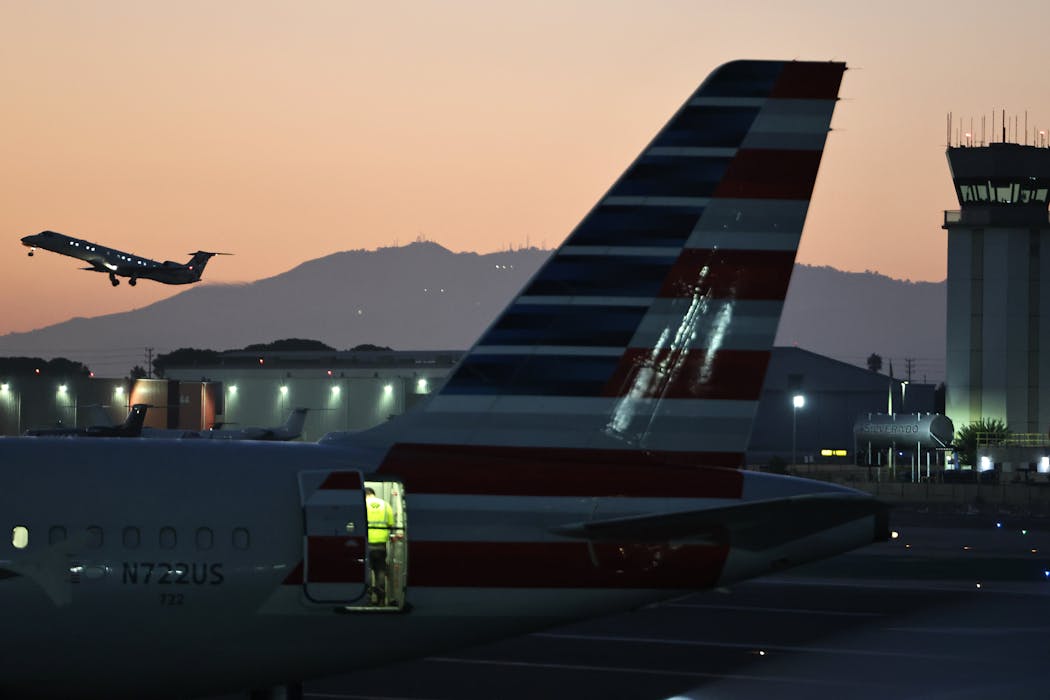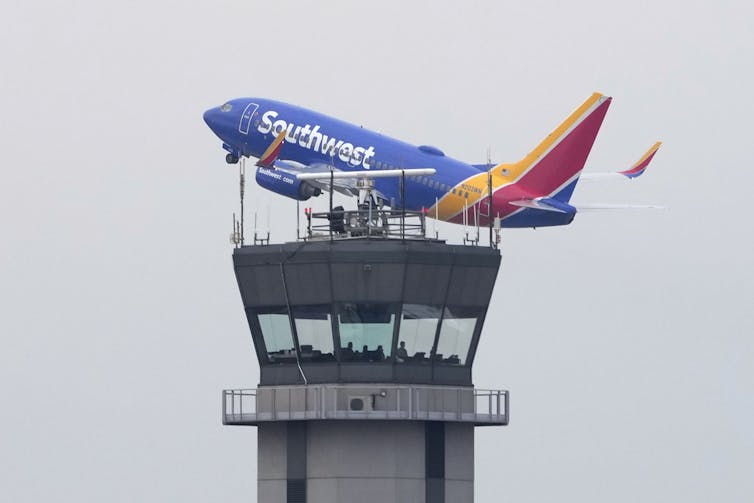How the government shutdown is making the air traffic controller shortage worse and leading to flight delays
- The government shutdown has exacerbated the air traffic controller shortage, leading to significant flight delays across the US.
- Air traffic controllers are working without pay due to the shutdown, resulting in financial stress and an increase in sick calls, with around 10% of the workforce engaging in this practice.
- The shortage has led to severe travel delays at major airports, including Atlanta, Denver, Burbank, California, and Daytona Beach, Florida, with thousands of flights delayed or canceled since the shutdown began.
- Despite concerns about air safety, contingency plans are in place to mitigate the impact, such as diverting flights away from affected locations or canceling them before departure, and the system has redundancies built into it to ensure a safe environment.
- The US is working to address the shortage through funding for modernizing the air traffic control system, with an additional $19 billion investment needed to complete the task, and Congress has authorized over $12 billion in funding to help with this effort.

Airports across the United States have been experiencing significant flight delays recently because of a shortage of air traffic controllers, who have been required to work without pay since a government shutdown began on Oct. 1, 2025. Reports suggest employees have been calling in sick in increased numbers. And since there was already a shortage of controllers before the shutdown, the impact has been severe, with thousands of flights delayed or canceled since the shutdown began.
The Conversation U.S. asked Brian Strzempkowski and Melanie Dickman, aviation experts at The Ohio State University, to explain how the shutdown is affecting air travel, what that means for passengers and air safety, as well as the air traffic controller shortage that has been plaguing U.S. airports for years.
How is the shutdown affecting air traffic controllers?
Air traffic controllers are deemed essential workers, meaning they are still required to work while not receiving compensation – which they would typically then receive in a lump sum after the shutdown ends. President Donald Trump created some uncertainty around this by suggesting workers may not get their back pay without explicit authorization from Congress, despite having signed a law in his first term that makes it a legal requirement.
Working without regular pay, combined with the possibility that they won’t get paid at all, is resulting in real financial stress for air traffic controllers, who perform one of the most stressful jobs there is.
As a result, there have been reports of air traffic controllers calling in sick in large numbers. This happened in previous shutdowns as well. During the 2018-2019 shutdown, for example, sickouts started to happen around the two-week mark, roughly when the first paycheck was missed. Controllers, airport security employees, and other essential workers were calling in sick often so they could work another part-time job to pay their bills.
In the current shutdown, this appears to be happening sooner, less than a week after it began. Transportation Secretary Sean Duffy said around 10% of the controller workforce is engaging in this practice and threatened to fire these “problem children.”
What does this mean for people about to take a flight?
Before the shutdown, there was already a critical shortage of air traffic controllers. Coupled with workers calling in sick in recent days, this has led to severe travel delays at many major airports, such as those in Atlanta and Denver, and regional ones, like those serving Burbank, California, and Daytona Beach, Florida.
A big question on travelers’ minds is whether this will affect air safety.
The air traffic control system is multi-layered and has redundancies built into it to ensure an incredibly safe environment. While controller shortages do begin to erode some of those redundancies, contingency plans are in place to help protect the system. For example, air traffic can be diverted away from affected locations or delayed, or the flight may even be be canceled before the plane leaves the gate.
As an example, Newark Liberty International Airport can accommodate approximately 80 aircraft departing or arriving per hour when the airport and airspace is fully operational. However, due to technical failures, staffing shortages and construction at the airport, capacity was limited to between 28 and 34 aircraft per hour in June 2025. Due to technology upgrades and procedural changes, that number was recently increased to between 68 and 72 aircraft per hour. By regulating the amount of traffic, the system can be protected to ensure the safety of every aircraft.
This was an example of high-level oversight in which the secretary of transportation was personally involved in seeking a solution to ensure air travel remained safe while trying to increase capacity.

AP Photo/Charles Rex Arbogast
How does the US keep air travel safe?
On a more day-to-day level, the Federal Aviation Administration relies on the Air Traffic Control System Command Center, located about 40 miles away from Washington, D.C. This facility oversees the entire national airspace system and essentially “controls” the controllers. Air traffic professionals monitor staffing at air traffic facilities, weather conditions, equipment failures and unexpected disruptions to the system.
When an incident arises, such as Burbank Airport recently reporting that no controllers were available, the command center issues an alert stating that any aircraft inbound to Burbank must divert to an alternate airport, and any aircraft that has not yet taken off will be held on the ground.
Staffing shortages at other air traffic control facilities may require alternate plans, such as transitioning workloads from one facility with fewer controllers, to another that is appropriately staffed. There is a wide range of tools that the Air Traffic Control System Command Center can utilize to protect the system, but it all stems from the idea of managing the capacity. Flight delays and cancellations, while disruptive to individual travelers, are actually good from a system perspective, because they prevent congestion in the airspace.
Why was there an air traffic controller shortage in the first place?
There has been a systemic problem with hiring of air traffic controllers for more than a decade.
Over the years, the FAA has fallen behind on training enough controllers to replace those who retire each year. In May 2025, we wrote about the FAA’s plan to utilize colleges across the country to provide the professional training for this career field. While it will take a little time for the students to matriculate through college and into the workforce, this plan will be a significant contributor to solving the controller shortage problem.
Meanwhile, the FAA Academy, which trains U.S. air traffic controllers, only has limited funding from the previous federal budget for current students. The shutdown means no new students can begin training. Depending on the length of the shutdown, the funding may run out as additional employees are furloughed. The ripple effects of a shutdown can remain for many months after the government reopens.
What’s the government doing to end the shortage?
In July, Congress authorized over US$12 billion in funding to help modernize the air traffic control system.
Secretary Duffy is currently leading an effort to identify a contractor to implement the technology upgrades needed to modernize the system and make it more robust. Duffy has said an additional $19 billion investment will be needed to complete the task.
The editor’s note was updated to correct the number of flights canceled during the shutdown.
![]()
Melanie Dickman is a member-at-large of Air Traffic Controllers Association (ATCA)
Brian Strzempkowski does not work for, consult, own shares in or receive funding from any company or organization that would benefit from this article, and has disclosed no relevant affiliations beyond their academic appointment.
